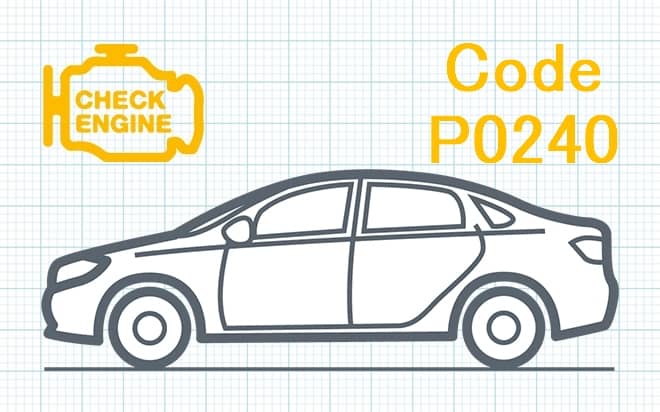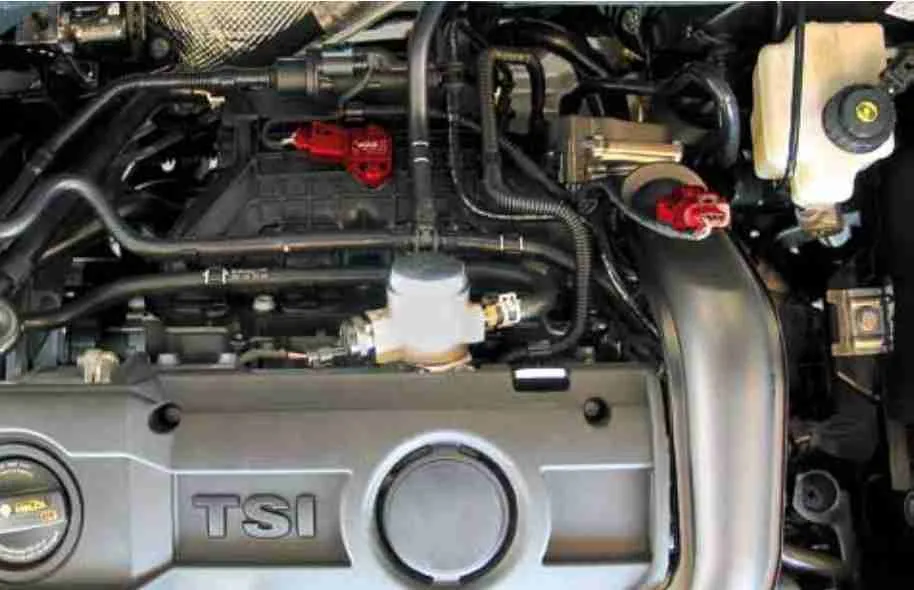
P0240 Turbocharger boost turbine “B” sensor signal level is out of range
Content
P0240 – OBD-II Trouble Code Technical Description
Trouble code P0240 indicates a problem with the turbocharger boost pressure sensor “B” signal level.
What does the fault code mean P0240?
Trouble code P0240 indicates that the Engine Control Module (ECM) has detected a discrepancy between the turbocharger boost pressure sensor “B” reading and the manifold absolute pressure sensor or atmospheric pressure sensor while the engine is idling or with the ignition on and the engine off. This may indicate problems with the turbocharger boost system or pressure sensors.

Possible reasons
Trouble code P0240 can be caused by several possible causes:
- Defective or damaged boost pressure sensor (turbocharger).
- Damaged or broken wires connecting the boost pressure sensor to the engine control module (ECM).
- Incorrect connection or malfunction of the ECM itself.
- A leak in the boost system, such as a crack in the inter-manifold hose or damage to the turbocharger.
- Problems with vacuum boost control.
- Malfunction or malfunction of the throttle valve.
- A malfunction in the exhaust system, such as a clogged catalyst.
It is important to carry out diagnostics to accurately determine the cause of the P0240 code in a particular case.
What are the symptoms of a fault code? P0240?
Symptoms when trouble code P0240 is present may vary depending on specific conditions and engine characteristics:
- Reduced Engine Power: Due to a problem with the turbocharger boost pressure, the engine may experience reduced power during acceleration.
- Increased fuel consumption: If the boost pressure is insufficient, the engine may require more fuel to maintain normal operation.
- Difficulty starting the engine: Low boost pressure can cause difficulty starting the engine, especially in cold conditions.
- Emission of Black Smoke: Low boost pressure may cause incomplete combustion of fuel, which may result in the emission of black smoke from the exhaust system.
- Check Engine Light Appears: Trouble code P0240 will activate the Check Engine light on the vehicle's instrument panel.
If you notice one or more of these symptoms, it is recommended that you contact a service center to diagnose and resolve the problem.
How to diagnose a fault code P0240?
Diagnosing the P0240 trouble code typically involves the following steps:
- Scan error codeA: An automotive diagnostic technician or mechanic should use an OBD-II scanner to read the P0240 error code and any other error codes that may be associated with the problem.
- Checking the boost pressure sensor: The boost pressure sensor (turbocharger) must be checked for damage or defects. This may include a visual inspection, checking connections and measuring its resistance or voltage.
- Checking wiring and connections: A mechanic should check the wiring and connections associated with the boost pressure sensor for breaks, corrosion, or other damage.
- Checking the boost system: The charging system, including the turbocharger and all connections, should be checked for leaks, damage or other problems.
- Checking vacuum lines and controls: If the vehicle uses a vacuum boost control system, the vacuum lines and controls must be checked for integrity and proper operation.
- Check ECM: In rare cases, the problem may be due to a faulty ECM. Testing its functionality may require specialized equipment.
Once the diagnostics are completed, your mechanic will be able to pinpoint the cause of the P0240 code and recommend appropriate repairs or replacement parts.
Diagnostic errors
When diagnosing DTC P0240, the following errors may occur:
- Incorrect interpretation of error code: Sometimes mechanics may misinterpret the P0240 code and begin replacing components without a thorough diagnosis. This can lead to unnecessary costs and ineffective repair efforts.
- Skip Boost Pressure Sensor Test: Some mechanics may focus on other aspects of the boost system without paying due attention to the boost pressure sensor. This may lead to missing a defect that may be associated with this particular sensor.
- Insufficient checking of the charging system: Sometimes mechanics may not have sufficiently checked the entire boost system, including the turbocharger and connections, which can lead to incomplete or incorrect conclusions about the causes of the P0240 code.
- Neglect of vacuum lines and control mechanisms: If your vehicle uses a vacuum boost control system, neglecting to check the vacuum lines and controls may result in missing important problems with these components.
- ECM malfunction: Sometimes mechanics may miss the possibility of a faulty engine control module (ECM) itself as the source of the problem, which can lead to needless replacement of other components.
To prevent these errors, it is important to carry out a complete and systematic diagnosis, taking into account all aspects of the charging system and interconnected components.
How serious is the fault code? P0240?
Trouble code P0240 is not always critical, but it does indicate problems with the turbocharger boost system or pressure sensors that can affect engine performance and efficiency. Although some vehicles may continue to function normally with this error code, it is recommended that you take it to a service center or mechanic to diagnose and repair the problem.
However, if a problem with the boost system or pressure sensors is left unattended, it can lead to further deterioration in engine performance, increased fuel consumption and even engine damage in some cases. Therefore, it is recommended to resolve the problem as soon as possible, especially if you notice changes in engine performance or other related symptoms.
What repair will help eliminate the code? P0240?
The repair to resolve the P0240 code depends on the specific cause of the error. Some possible repair methods may be as follows:
- Boost pressure sensor replacement: If the problem is due to a defective or damaged boost pressure sensor, it should be replaced with a new one and adjusted correctly.
- Repair or replacement of wiring and connections: If breaks, corrosion or other damage is found in the wiring or connections, they must be repaired or replaced.
- Repairing leaks in the boost system: If leaks are detected in the charging system, such as cracks in the inter-manifold hose or damage to the turbocharger, it is necessary to eliminate these leaks by repairing or replacing the relevant components.
- Checking and replacing vacuum lines and control mechanisms: If the vehicle uses a vacuum boost control system, faulty or damaged vacuum lines and controls may also need to be replaced.
- Check and possible replacement of ECM: In rare cases, the problem may be due to a problem with the Engine Control Module (ECM) itself, and its functionality may require testing and, if necessary, replacement.
Repairs should be carried out by a qualified mechanic or specialist service center after a thorough diagnosis to ensure the problem is properly resolved and to prevent reoccurrence.
P0240 – Brand-specific information
Trouble code P0240 relates to the turbocharger boost system and can be common to many makes and models of cars, several P0240 codes for some popular brands:
- BMW: P0240 – Low turbocharger boost pressure.
- Ford: P0240 – Low pressure of turbocharger “B” (depending on model).
- Volkswagen/Audi: P0240 – Turbocharger boost pressure “A” – Intermittently (depending on model).
- Toyota: P0240 – System turbocharger (TC) boost pressure is low.
- Chevrolet / GMC: P0240 – Boost pressure sensor “B” – signal too high (depending on model).
These are just some examples. The meaning of the P0240 code may vary slightly depending on the specific model and year of the vehicle. It is important to consider this information in the context of your specific vehicle when diagnosing and repairing.
